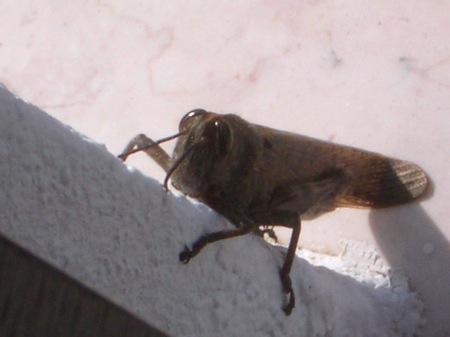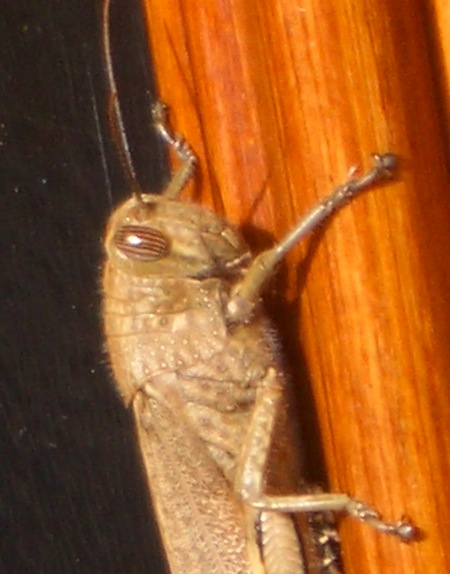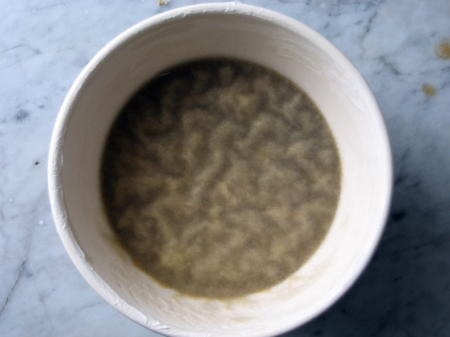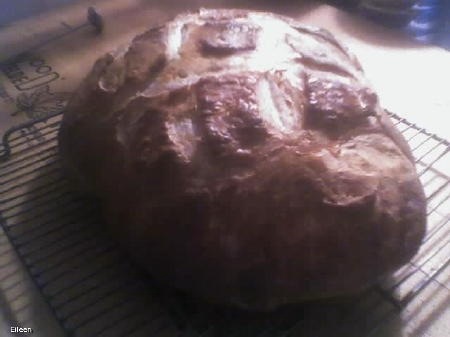
We in fact do not live alone here in our house on Via Strada Nuova. The house shares its rooms with a seasonal wave of insects, whether we like it or not.
In the summer the heavy hot air vibrates with mosquitoes, hovering by ears with an infuriating buzz. These zanzare tigre are particularly vicious, on some kind of bend of bloodthirsty anger. Luciano is used to it, having lived his whole life stoically putting up with them. But I couldn’t stand it, coming from Berkeley where one or two mosquitoes lackadaisically show up once a year for a half-hearted stab at my ear. In Mareno, where I seem to be fresh meat, I sit awake at night glaring at the walls searching out the bitch who somehow got inside.
We had an elaborate system of keeping the darkened bedroom windows open and the door closed before bed. As we entered the room, cooler than the rest of the house, we would slam the windows shut and only then turn on the lights. Now we have screens installed in every window, a luxury feature here which has changed my life. Yet there still seems to be one or two who slip in with us and I must kill them all before I can sleep. In the meantime Luciano peacefully snores away.
While teaching my nine-year old student Matteo, a mosquito bit him, twice. We both stopped the lesson to hunt her down.
“Here! I found her!” Matteo cried out, moving toward the window with his English book. There, perched on the pristine white curtains was the fat, happy, doomed beast. Matteo arched back to swing and I jumped to protect the curtain.
“Nooo! Wait. There! See, she is moving.”
The mosquito had moved drunkenly to the floor where Matteo brought his book down, hard, and as I’d expected, a blossom of blood splashed out across the floor.
As a final snub to mosquitoes, we simply leave Italy every summer, thus eliminating two people from their diet. And for two months the house stands empty…or we like to think it is empty. For every September when we return, we find the first floor inhabited by black beetles. About a half an inch long and with shiny backs, the beetles just sort of hang out, moving sluggishly, if at all, when we turn on the lights or enter a room. We find three or four every day, moving indolently across the floor. Once I found one sitting on the ottoman in the living room, waiting for us to start up a movie, I am sure. Being such slow moving targets, they are easy to kill, but then I have to clean them up. Yuck.
Luciano explains the infestation, “Serena, we live in the country. It happens.” I noticed he had stepped on one, but had left the body untouched. I pointed at the evidence.
“I left it there as an example to the others,” he explained.
The body lay where it was for a day then, and seeing that it had no ill-effect on the others, I cleaned it up. For weeks I resignedly shake out my shoes and pause at the bottom of the stairs. I think that while we are gone they move in and party all summer long only to be shocked in September to find that they have to share the house. When this sinks in, they move on, to party elsewhere I imagine, because now they are gone.
…Only to be replaced with an even more feared creature: the cavalletta, or grasshopper. But at four inches long, with enormous eyes and an Attitude, they are like no grasshopper I have ever seen. We find them now, clinging tenaciously to the shutters of the house, poised to attack at the slightest provocation. Unhappy to discover one sitting in my flower garden, I went after it with a broom. The cavalletta clutched the branch it had been occupying with its armored and spurred legs, watching me disdainfully as I swung at it. Suddenly it flew up on wings the size of a small bird, and then right at me! I dropped the broom and fled to the relative safety of the house, where I found Luciano had been watching from the window. Normally fearless in the face of insects, he is equally creeped out by these beasts and is no help. We both know who we must call: his mother.
Anna Maria laughs at us. “What is your problem? They are just bugs. Watch.”
A cavalletta had attached itself high on the side of the house and Anna Maria, without hesitating, pulled a long metal pole out from under the wall of ivy, as if it were there just for this purpose. She deftly tapped the bug, who must have known the jig was up and it was doomed, released its iron grip on the house and dropped to the terrace, where it hit with a solid thunk. Again, with no qualms, Anna Maria moved in with a napkin, scooped up the bug and threw the wad at the terra cotta tiles. Whump!
“Vedi? E facile". See? It’s easy. She picked up the motionless corpse, smiled at me and said, “Umido”. The bug was going to join the banana peels and coffee grounds in the compost bucket.
I have no illusions of ever matching this level of bravery.
I must not complain, though, as I have not yet met the ultimate roommate of our house in the country. As Luciano walked into our library one evening, he hit something with his toe that skittered across the floor. On closer inspection, he found that he had kicked a scorpion across the room. A scorpion. A little dazed, it sat motionless, probably as shocked as anybody. Meanwhile, as Luciano prepared to kill the beast, he called in back up. Bursting with curiosity, Anna Maria rushed over this time with three napkins (it was that kind of job) and quickly dispatched the monster before Luciano could---or it could collect its wits.
She smiled at Luciano, utterly amused by our collective terror.
“Umido”.

In fact, to get a starter to a point where it can be used to make bread takes twelve days. Twelve days. I am usually looking for a recipe I can whip up in four hours. Twelve days? I always skip over that section, until I carried home the spongy white mass in a bowl, like an adopted puppy waiting to be loved.
This starter needs to be fed regularly with a diet of warm water and flour. I found myself living in fear that I might kill it, and watching it, fascinated to see it bubble and grow using only the natural yeast in the air. It took on that wonderful slightly sour smell. But with an eye always on the calendar, I worried when we went away for the weekend like a new mother of a Tamagotchi electronic pet.
Then one day I felt ready to make bread. Reading the directions carefully, I activated the starter. Then there was no turning back. I had given it life and cancelled dinner party or not, it was going to become bread. With a bit set aside to carry on the lineage, it magically puffed into a fat delicious loaf. A miracle.
Once back in Italy, I am determined to recreate sourdough bread here. What is all this malarkey about the fog? I carefully measured out the initial flour and water to begin a new life. I did not use the organic rye flour as indicated in the cookbook I dragged back with me. But who has that lying around the house? Besides, it had worked in Berkeley with regular flour. Luciano was dubious.
“Do you think there is yeast in the air here?”
“There has got to be. How can Italy be yeast free and California loaded with it? Isn’t yeast universal?”
Clearly this is something that Luciano had never pondered, nor had I for that matter.
I watched the bowl of flour and water on the counter and sure enough, after a few hours, bubbles appeared and it began to grow…and grow. There is indeed yeast in the air here and it is pretty darn lively. But I also noticed a smell that grew with each hour. It was impossible to deny that the stench came from the thing coming to life on the counter. By the second day it was clear that whatever was in the air in Italy, we could not live with it in the house, much less eat it. I asked Luciano to take the wrapped bowl across the lane and throw it away in the field, the campo. Naively, he agreeably picked up the bowl and walked out the door, oblivious to the potential power under that plastic wrap. There behind the hedge of bushes I could hear the poor man retching as he scraped the toxic mass into the high grass. He came back, tears in his eyes.
“That was awful.”
I tried again, this time with organic rye flour. There had to be a way to reproduce this bread. How could it be true that it can only be made in San Francisco? I carefully measured in the water and flour at the correct times and while it did not take on the stink of the last batch, a warm, brown fuzzy growth of mold took off on the bubbly surface. Again, it did not inspire baking, but this time I took it out to the campo myself and scraped it into the receptive earth where I am sure it goes on living, in its own way.

Having established the yeast in the air, I decided the problem lies in the water and flour. This is my third and last attempt. I promise. This time I again began with organic rye flour, but instead of the Italian flour, I am now feeding it bottled water and what is advertised as farina d’America which is flour in fact produced by “Friends of Manitoba” in Canada. Hmmm. I shall forget for a moment that Italian Tipo 00 farina is sold at Monterey Market in Berkeley for about five bucks for a tiny little package. It is deadly if left to its own devices.
Currently the pampered mass is bubbling up properly, does not yet smell, nor is it growing a furry coat. It has another three or four days before it is mature enough to be called sourdough starter, but I am optimistic despite comments from Luciano such as, “You so need a pet.” Or his laments to puzzled friends about the science experiment going on in our kitchen. One sympathetic friend gave me a recipe for sourdough from her Italian cookbook. Right there is the list of ingredients I saw “add one package of yeast.” Clearly, this is bogus and I am not going to fall for it. Especially since we now know that Italian air is full of enthusiastic yeast. It is a wonder we can all breath. Still, I am relieved that Luciano has not told Anna Maria about my experiment yet. The teasing could be too much to bear unless I can actually produce a loaf of chewy, crunchy San Francisco style sourdough bread...in Italy.
And the starter from Berkeley? Unable to throw it away, before leaving I passed to on to my friend Eileen who now proudly sends me baby pictures of the resulting loaves as it thrives in the California air. I am so happy for her. Now if only I can harness the obvious zippiness of the Italian air yeast, I won’t regret having finally been enticed to stop in the sourdough section of that cookbook…






